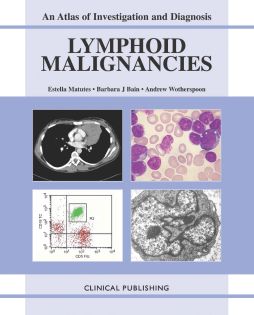
BOOK
Lymphoid Malignancies: an Atlas of Investigation and Diagnosis
E Matutes, B Bain, A Wotherspoon
(2007)
Additional Information
Book Details
Abstract
Meeting the needs for haematologists and clinical chemists for an up to date reference, this atlas provides a visual presentation of lymphoproliferative disorders, leukaemia and plasma cell neoplasms. Compiled by leading experts in the UK, each malignancy is surveyed based on molecular and cellular changes, including histochemistry, cytochemistry and relevant radiographs. Pertinent clinical information relating to clinical presentation, differential diagnosis and prognostic indicators are concisely outlined, using numerous graphics and citing key references in the field. A companion volume in the series will comprise an illustrated guide to myeloid malignancies.
Table of Contents
| Section Title | Page | Action | Price |
|---|---|---|---|
| About This Book | |||
| 7 Section A: Identifying the Nature of the Task | |||
| 9 Chapter 1 Communication | |||
| 9 Communication as a Process | |||
| 10 Source | |||
| 10 Message | |||
| 11 Channel | |||
| 1 1 Audience | |||
| 12 Effects | |||
| 12 Feedback | |||
| 13 Communication as Common Understanding | |||
| 14 Problems in Communication | |||
| 17 Chapter 2 Audience and Message | |||
| 1 7 Finding Out about the Audience | |||
| 1 8 How to Find Out | |||
| 1 9 Steps in a Simple Survey | |||
| 28 Preparing the Message | |||
| 30 Deciding on the Topic | |||
| 30 Studying the Topic | |||
| 32 Chapter 3 Aims and Objectives | |||
| 32 Aims | |||
| 32 Objectives | |||
| 33 Motivation | |||
| 35 Section B: Making Choices — Methods and Media | |||
| 37 Chapter 4 The Range of Possibilities | |||
| 37 Factors in Making a Choice | |||
| 37 A Multi-Media Approach | |||
| 40 Methods and Media — An Overall View | |||
| 41 Chapter 5 Narrowing the Field | |||
| 41 Communication Methods | |||
| 41 Learning through Achievement | |||
| 42 Simulation: Models, Games, Drama, Puppetry | |||
| 44 Story-telling | |||
| 44 Song | |||
| 45 Discussion | |||
| 45 Field Trip | |||
| 45 Demonstration | |||
| 46 Talk or Lecture | |||
| 46 Exhibition | |||
| 47 Low-Cost Media | |||
| 48 Sound Recordings | |||
| 48 Visual Aids:_ Projected, Three-Dimensional, Printed Material | |||
| 52 Case Study Exercise | |||
| 5 7 Section C: Using Printed Material | |||
| 59 Chapter 6 Why Use Printed Material? | |||
| 59 What is Printing? | |||
| 59 Advantages of Printed Material as a Medium | |||
| 59 Disadvantages and Problems | |||
| 60 Low-Cost Printing | |||
| 60 Centralized and Local Production | |||
| 61 Some Possible Alternatives | |||
| 62 Chapter 7 Forming the Message | |||
| 6 2 Contents | |||
| 62 Information | |||
| 64 Approach | |||
| 65 Writing Simply | |||
| 67 Choosing Illustrations | |||
| 67 Picture Recognition | |||
| 69 Picture Style | |||
| 71 Symbols | |||
| 73 Diagrams | |||
| 75 Using Illustrations | |||
| 7 9 Pretesting | |||
| 83 Using a Questionnaire | |||
| 86 Analysing Findings | |||
| 90 Some Final Comments | |||
| 91 Glossary | |||
| 94 References | |||
| 95 Bibliography |
